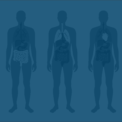Resource Library
Health Challenges In Addiction Recovery

The wide range of injuries inflicted on the human body by excessive and prolonged alcohol or other drug (AOD) use have been extensively documented for more than two centuries, but until recently little was known about the relative health of people recovering from addiction. The potential burden of continued health problems in recovery has been obscured by general findings of improved health and quality of life in recovery from follow-up studies of clinical samples. Little information has been available on the health status of people in recovery within larger community samples.
In 2010, the Philadelphia Department of Behavioral Health and Intellectual disAbility Services contracted with the Public Health Management Corporation (PHMC) to incorporate recovery-focused items into PHMC’s Southeastern Pennsylvania Household Health Survey of Philadelphia and four surrounding counties. Nearly ten percent (9.45%) of the adult population surveyed reported once having but no longer having an AOD problem. Those in recovery, compared to citizens not in recovery, were twice as likely to describe their health as poor and report higher rates of asthma, diabetes, high blood pressure, obesity and past-year emergency room visits. They were also more likely to report lifetime smoking (82% vs. 44%), current smoking (50% vs. 17%), exposure to smoke in their residence, no daily exercise, and eating fast food three or more times per week. In terms of resources to address health concerns, people in recovery compared to the general population reported greater family/social isolation, lower income, less insurance coverage, and less likelihood of past year health screenings, primary health care, and dental care.
While the Philadelphia survey findings were alarming, it remained unclear whether the survey findings were representative of all people in recovery in the United States. A just-published study by Eddie and colleagues reports strikingly similar findings in a nationally representative sample of the adult U.S. population. Relative to the general population, those self-reporting having resolved an AOD problem report higher rates of hepatitis C, HIV/AIDS, chronic obstructive pulmonary disease, heart disease, and diabetes. Quality of life among people in recovery was lower when one or more of these diseases were present.
The findings from the Philadelphia and U.S. surveys reveal the burdens of disease that can continue into the addiction recovery process–burdens that if unattended can plague personal health and quality of personal and family life for years to come. Such findings have profound implications for the state of professional care for AOD problems in the United States. At a systems level, we have a model of care that functions as an emergency room to provide acute biopsychosocial stabilization but is not designed to provide long-term health management for people in addiction recovery. The management of other chronic health disorders (e.g., diabetes, hypertension, asthma, etc.) is now viewed as requiring the management of global health (e.g., management of co-occurring medical conditions, diet, exercise, psychosocial stressors) over a prolonged if not lifelong period of time. It is past time that the treatment of the most severe and complex AOD problems was similarly conceived. Such approaches would move beyond brief episodes of symptom amelioration (recovery initiation and diagnostic remission) to the promotion of global health and quality of personal, family, and community life in long-term recovery.
At its most practical level, the survey findings suggest that every person entering recovery should have an ongoing relationship with a primary care physician who is knowledgeable about addiction recovery and who can serve as an ongoing consultant on the achievement of health and wellness. It also suggests the need for increased bi-directional integration of addiction treatment and primary health care and the potential role of the primary care physician in performing ongoing recovery checkups. Hopefully, the day when such integration constitutes mainstream practice will arrive soon.
References
Eddie, D., Greene, C., White, W. L. & Kelly, J. F. (in press). Medical burden of disease among individuals in recovery from alcohol and drug problems in the United States: Findings from the National Recovery Study. Journal of Addiction Medicine.
White, W. L., Weingartner, R. M., Levine, M., Evans, A. C., & Lamb, R. (2013). Recovery prevalence and health profile of people in recovery: Results of a Southeastern Pennsylvania survey on the resolution of alcohol and other drug problems. Journal of Psychoactive Drugs, 45(4), 287-296.
